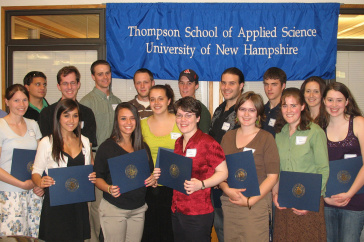UNH Coastal Response Research Center, NOAA, EPA and Coast Guard Convene Science Meeting to Study Dispersant Use and Ecosystem Impacts of Dispersed Oil in the Gulf of Mexico

Front row: Elizabeth Kramlinger Audrey Perkins, Shannon Cordeiro, Megan Fleming, Sheri Martin, Kristen Dietrich, Jenny Dorman, Emily Kunelius, Sarah Fargo, Leon Cornell. Back row: Scott Hammond, Peter Hoffman, Andrew Kopp, William Kunelius, John Stephens, Chris Ouellette, Benjamin Hughes, Tanner Hutchins, Katelyn Guay. (Courtesy photo)
DURHAM, N.H. - More than 50 experts and practitioners from government, academia and industry finished a two-day meeting Thursday, May 27, 2010, looking at the potential long-term impacts of the prolonged use of large volumes of dispersants in the Deepwater Horizon oil spill response efforts in the Gulf of Mexico. This is the third time NOAA and EPA have gathered top scientists to discuss dispersant use since the spill began. EPA and NOAA scientists are conducting rigorous ongoing monitoring and analysis of the effectiveness and toxicity of the dispersants used.
Should data indicate that the dispersants are causing significant environmental damage that outweighs the benefits of their use, EPA and the Coast Guard reserve the right to discontinue use.
Although the crude oil is more toxic than the authorized dispersants, much is unknown about the long-term environmental impacts of dispersants when used in these unprecedented volumes on the surface and in the subsea. Because of this and due to the effectiveness of subsea applications, EPA and the U.S. Coast Guard directed BP to significantly ramp down their use of dispersants. BP has complied and has significantly reduced dispersant use.
The purpose of the two-day meeting was to provide input to the Gulf of Mexico Regional Response Teams (4 and 6) on the use of dispersants and the effects of dispersed oil going forward in the Deepwater Horizon incident. The meeting also identified possible monitoring protocols to be used in the event of continued aerial applications to surface water and subsea use.
"This conference provided us with additional scientific information about potential impacts of prolonged dispersant use that can help guide decision making as we continue to support the U.S. Coast Guard's response to and clean up of this spill," said Craig Carroll, EPA co-chair of the Region 6 Regional Response Team.
"It is the consensus of the group that up to this point, use of dispersants and the effects of dispersing oil into the water column has generally been less environmentally harmful than allowing the oil to migrate on the surface into the sensitive wetlands and near shore coastal habitats," said Nancy Kinner, University of New Hampshire co-director of the Coastal Response Research Center.
"The meeting is adding to our knowledge, both in terms of helping identify key questions that should be asked and helping identifying new, quality sources of information and relevant expertise to draw on as we make these difficult decisions," said Charlie Henry, NOAA's scientific support coordinator for the Unified Command Center in Roberts, La.
"The thoughtful scientific input from this meeting will prove valuable to responders as we continue to do everything possible to minimize damages caused by this unprecedented spill," said Robert Pond of the U.S. Coast Guard.
This was the third science summit in three weeks that builds on the unprecedented mobilization of science the federal government has brought to this incident. The administration has engaged some of the world's brightest scientific minds from the public and private sectors to mitigate the oil's impact and ensure an effective response.
The results of the meeting will be presented in a report to the Regional Response Teams within the next week. The report will be available on the CRRC website at www.crrc.unh.edu.
-30-
Latest News
-
July 2, 2024
-
June 18, 2024
-
June 18, 2024
-
May 17, 2024
-
May 14, 2024

















































